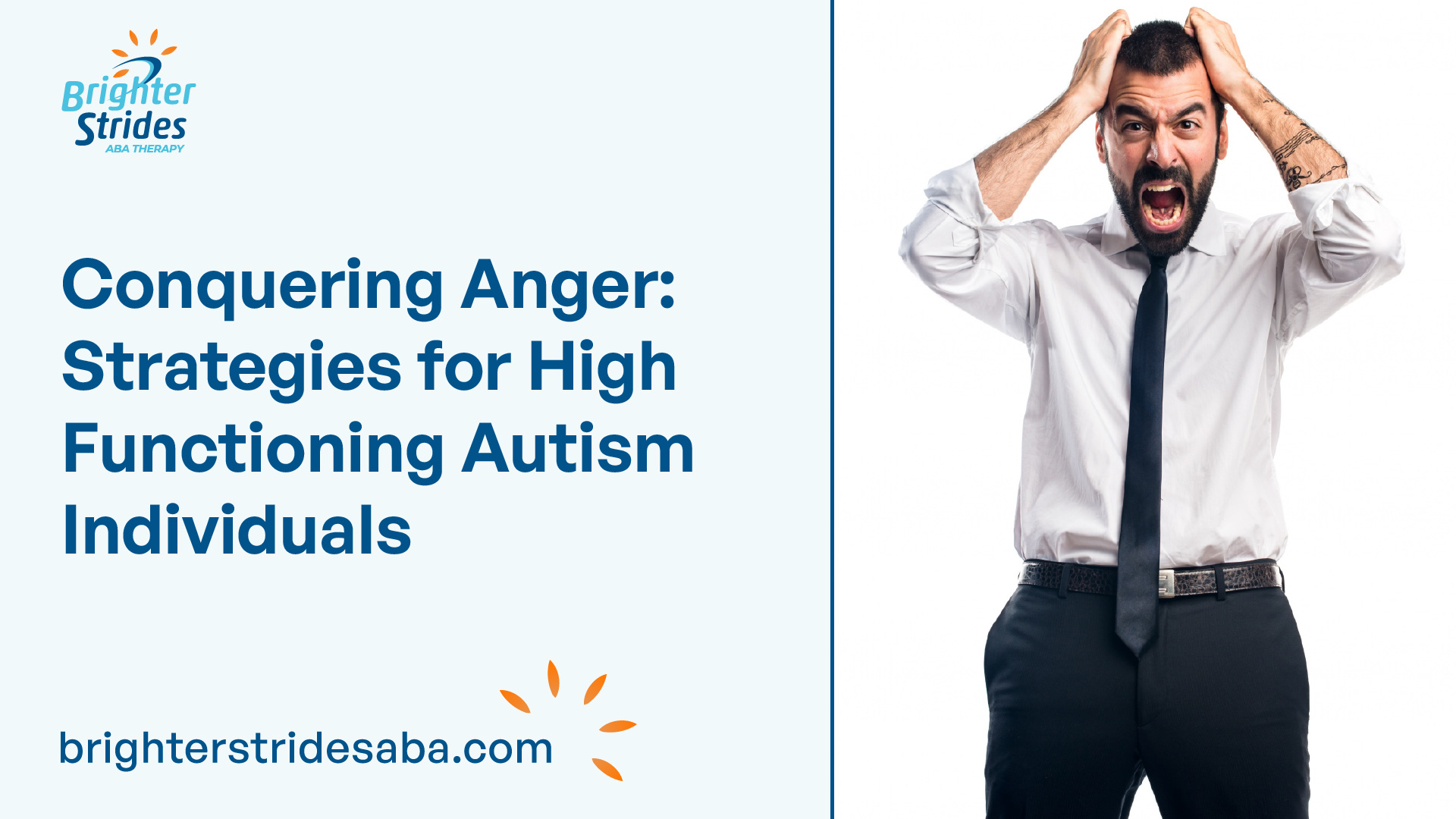Understanding High-Functioning Autism
High-Functioning Autism (HFA), also known as Level 1 Autism Spectrum Disorder, refers to individuals who are on the most functional end of the autism spectrum. These individuals exhibit better communication skills and cognitive functioning compared to others on the spectrum. Despite their higher functioning, they still face unique challenges, including difficulties with anger.

Characteristics of HFA
Children diagnosed with high-functioning autism display a range of characteristics that differentiate them from individuals with other autism spectrum disorders. Some common characteristics of HFA include:
- Difficulty with social interactions and understanding social cues
- Restricted interests and repetitive behaviors
- Strong adherence to routines and difficulty with changes
- Sensory sensitivities and aversions
- Advanced language skills and cognitive abilities compared to others on the autism spectrum
- Higher level of independence in daily tasks
Challenges Faced by Individuals
Despite their comparatively higher cognitive and communication abilities, individuals with high-functioning autism face various challenges, including difficulties with anger, frustration, and anxiety. These challenges can manifest in aggressive behaviors such as destruction of items and self-harm.
The difficulties in managing anger experienced by individuals with high-functioning autism can be attributed to various triggers. These triggers may include sensory overload, difficulty in communication, changes in routine, and feeling overwhelmed or frustrated. It is essential to provide individuals with HFA the necessary support and resources to cope with these challenges effectively.
Understanding the characteristics and challenges associated with high-functioning autism is a crucial step in developing strategies to address and manage anger in individuals with HFA. By recognizing their unique needs and providing appropriate support, we can help them navigate their emotions and enhance their overall well-being.
Anger in High-Functioning Autism
Individuals with high-functioning autism (HFA) often face unique challenges, including difficulties with anger. Understanding the triggers of anger and how it is expressed in HFA is crucial for developing effective strategies to manage this emotion.
Triggers of Anger
Anger in high-functioning autism can be triggered by various factors. Sensory processing difficulties, such as sensory overload, can contribute to feelings of frustration and anger. Changes in routine, being overwhelmed by multiple tasks, and intolerance of imperfections in others are common triggers for anger in individuals with HFA [1]. Additionally, stress, anxiety, anger rumination, impulse control issues, and medical issues can further exacerbate anger in high-functioning autistic individuals [1].
Expressing Anger in HFA
The expression of anger in high-functioning autism can vary from person to person. Some individuals may exhibit aggressive behaviors, such as destruction of items or violence towards others, while others may struggle with verbal outbursts or meltdowns. It’s essential to recognize that autistic anger is different from tantrums in neurotypical children. Autistic anger is often impulsive and lacks reasoning behind it, usually in response to challenging situations like sensory overload or unexpected changes.
Understanding the triggers and expressions of anger in high-functioning autism is the first step towards developing effective strategies to manage this emotion. By identifying specific triggers and implementing appropriate coping mechanisms, individuals with HFA can learn to navigate their anger in a healthy and constructive manner.
The Rage Cycle
In individuals with high-functioning autism (HFA), anger can often manifest through what is known as the rage cycle. The rage cycle consists of three stages: escalation, explosion, and recovery. Understanding these stages and implementing strategies to manage anger cycles can be beneficial for individuals with HFA and those around them.
Three Stages Explained
- Escalation: In the escalation stage, anger begins to build up. This may be triggered by various factors such as sensory overload, difficulties with communication, or feeling overwhelmed. During this stage, individuals with HFA may exhibit signs of irritability, restlessness, increased tension, and a heightened emotional state.
- Explosion: The explosion stage is characterized by an outburst of anger. This can involve physical aggression, verbal outbursts, or self-harming behaviors. It is important to note that these behaviors are not a reflection of the individual’s character, but rather a response to the overwhelming emotions they are experiencing.
- Recovery: After the outburst, individuals with HFA enter the recovery stage. During this phase, they may experience feelings of guilt, shame, or embarrassment. It is crucial to provide support and understanding during this time, as recovery allows for reflection and the opportunity to learn coping strategies for future situations.
Managing Anger Cycles
Managing anger cycles in individuals with HFA involves both proactive and reactive strategies. Here are some approaches that can be helpful:
Proactive Strategies:
- Establishing routines and predictable schedules to minimize anxiety and stress.
- Teaching and practicing relaxation techniques, such as deep breathing exercises or mindfulness activities.
- Providing opportunities for sensory regulation through activities such as sensory breaks or engaging in calming sensory experiences.
- Using visual supports, such as visual schedules or social stories, to help individuals understand and navigate their emotions.
Reactive Strategies:
- Implementing a calm-down plan that includes a designated safe space or sensory toolkit where individuals can retreat when feeling overwhelmed.
- Encouraging the use of communication tools, such as visual or verbal cues, to express feelings and needs.
- Teaching and practicing problem-solving skills to help individuals find alternative ways to manage their anger.
- Seeking professional support through therapy, such as cognitive-behavioral therapy, to develop coping mechanisms and address underlying issues.
By understanding the stages of the rage cycle and implementing effective strategies, individuals with HFA can learn to manage their anger in a healthy way. It is important to remember that each person is unique, and strategies should be tailored to their specific needs and preferences. Providing a supportive and understanding environment can greatly contribute to the overall well-being of individuals with HFA.
Treatment Approaches
When it comes to addressing anger in individuals with high-functioning autism (HFA), there are various treatment approaches available. These approaches aim to help individuals manage their anger, develop coping strategies, and improve their overall emotional well-being. Two commonly used treatment approaches for high-functioning autism are Applied Behavioral Analysis (ABA) and Collaborative and Proactive Solutions (CPS).
Applied Behavioral Analysis (ABA)
Applied Behavioral Analysis (ABA) therapy is an effective treatment option for individuals with high-functioning autism who struggle with anger and aggressive behaviors. ABA therapy utilizes techniques such as positive reinforcement, neutral redirection, alternative behaviors, proactive intervention, modeling techniques, and positive feedback to teach anger management skills.
The primary goal of ABA therapy is to modify behavior and teach individuals with HFA how to respond to anger triggers in a more adaptive and socially appropriate manner. Through structured sessions and consistent reinforcement, individuals learn to identify and regulate their emotions, develop coping strategies, and communicate their needs effectively.
ABA therapy is tailored to the individual’s specific needs and focuses on building skills gradually. Therapists work closely with individuals to identify triggers, develop self-awareness, and implement strategies for anger management. With time and practice, individuals with HFA can learn to navigate their anger more effectively and reduce aggressive behaviors.
Collaborative and Proactive Solutions (CPS)
Collaborative and Proactive Solutions (CPS) is another approach that can be effective for managing anger in individuals with high-functioning autism. CPS focuses on changing how individuals view and solve problems by promoting collaboration between parents and children.
CPS involves a structured problem-solving approach where parents and individuals with HFA work together to identify delayed skills, discuss problems, and find mutually beneficial solutions. By involving the individual in the process, CPS aims to empower them and provide them with a sense of control over their anger management.
This approach recognizes that individuals with high-functioning autism may have difficulty expressing their emotions and communicating their needs. By focusing on collaboration and understanding, CPS helps individuals build essential skills in problem-solving, emotional regulation, and communication.
CPS has shown positive outcomes for children with oppositional defiance disorder (ODD) and attention-deficit/hyperactivity disorder (ADHD) and may also be beneficial for children with high-functioning autism. It provides a supportive framework that encourages individuals to express their feelings, address underlying issues, and develop effective strategies for managing anger.
Both ABA therapy and CPS offer valuable tools and techniques for individuals with high-functioning autism to better understand and manage their anger. These treatment approaches provide structured support and intervention to promote emotional well-being, improve social interactions, and enhance overall quality of life.
Coping Strategies
When it comes to managing anger in individuals with high-functioning autism (HFA), coping strategies play a crucial role. These strategies aim to help individuals regulate their emotions, identify triggers, and develop effective techniques to cope with anger. Two important coping strategies for individuals with HFA are self-regulation techniques and identifying triggers.
Self-Regulation Techniques
Self-regulation techniques can be beneficial in helping individuals with HFA manage anger outbursts caused by sensory overload. These techniques focus on providing individuals with strategies to calm themselves down and regain control of their emotions.
Here are some self-regulation techniques that can be helpful:
- Deep Breathing: Encouraging slow, deep breaths can help individuals relax and reduce feelings of anger and stress. Inhaling deeply through the nose and exhaling slowly through the mouth can promote a sense of calm.
- Mindfulness: Practicing mindfulness techniques, such as meditation or guided imagery, can help individuals with HFA become more aware of their emotions and regulate their responses. Mindfulness exercises focus on being present in the moment, allowing individuals to observe their thoughts and feelings without judgment.
- Sensory-Based Activities: Engaging in sensory-based activities, such as squeezing a stress ball, listening to calming music, or using a weighted blanket, can provide a soothing effect and redirect attention away from anger triggers.
Implementing these self-regulation techniques can help individuals with HFA manage their anger and prevent it from escalating into aggressive behaviors. It is important to tailor these techniques to the individual’s preferences and sensory needs, as each person with HFA may respond differently to various strategies.
Identifying Triggers
Identifying personal triggers and common triggers associated with high-functioning autism is crucial for effectively managing and preventing anger outbursts. Understanding what triggers anger allows individuals with HFA and their support network to develop personalized strategies and create a supportive environment.
Here are some common triggers that individuals with HFA may experience:
TriggersChanges in routineSensory overloadCommunication challengesFrustration due to difficulty expressing needsFeelings of confusion or helplessness
By identifying these triggers, individuals with HFA and their caregivers can work together to develop strategies to prevent or minimize anger outbursts. This may involve creating visual schedules or social stories to prepare for changes in routine, providing sensory breaks or a quiet space to manage sensory overload, and implementing alternative communication methods to help individuals express their needs and emotions effectively.
Remember, each individual with HFA is unique, and triggers may vary from person to person. By gaining insight into personal triggers and implementing appropriate coping strategies, individuals with HFA can better manage their anger and improve their overall emotional well-being.
Support and Resources
Individuals with high-functioning autism (HFA) may face challenges in managing their emotions, particularly anger, due to various triggers and difficulties in communication and emotional regulation. It is important for individuals with HFA to have access to appropriate support and resources to help them cope with these challenges.
Aiding Individuals with HFA
Supporting individuals with HFA in managing their anger involves a multi-faceted approach that addresses their unique needs. Here are some strategies that can be helpful:
- Therapeutic Interventions: Psychotherapy, such as cognitive-behavioral therapy (CBT), can provide individuals with HFA the tools and techniques to manage their anger. CBT helps identify triggers, develop coping skills, and improve emotional regulation.
- Social Skills Training: Teaching social skills can help individuals with HFA improve their communication and understanding of social cues. This can reduce misunderstandings and frustration, leading to better anger management.
- Sensory Support: Sensory overload can be a trigger for anger in individuals with HFA. Providing sensory support, such as noise-canceling headphones or a calm sensory space, can help individuals regulate their sensory input and reduce anger triggers.
- Visual Supports: Visual aids, such as social stories or visual schedules, can help individuals with HFA understand and navigate their environment. This can enhance their ability to cope with changes and reduce anger-inducing situations.
- Individualized Strategies: Recognizing that each individual with HFA is unique, personalized strategies tailored to their specific needs and triggers can be developed with the help of professionals, caregivers, and educators.
Medication Considerations
While there is no specific medication for treating anger in individuals with HFA, medications may be considered to manage underlying symptoms that contribute to anger, such as anxiety, depression, or obsessive-compulsive behaviors. It is important to note that medication should always be used as part of a comprehensive treatment plan and under the guidance of a qualified healthcare professional.
Here are some medication considerations for individuals with HFA:
- Anxiety Medications: Medications such as selective serotonin reuptake inhibitors (SSRIs) or benzodiazepines may be prescribed to manage anxiety symptoms that can contribute to anger.
- Mood Stabilizers: In some cases, mood stabilizers such as anticonvulsants or atypical antipsychotics may be prescribed to help regulate mood and reduce irritability or aggression.
- Consultation with a Healthcare Professional: It is crucial to consult with a qualified healthcare professional who specializes in autism spectrum disorders to determine the appropriateness and potential benefits of medication for an individual with HFA.
It is important to remember that medication should always be considered as part of a holistic approach that includes therapy, support, and other coping strategies for managing anger in individuals with HFA. The goal is to provide a comprehensive support system that addresses the unique challenges faced by individuals with HFA and promotes their overall well-being.
References
- https://www.goldencaretherapy.com/high-functioning-autism-and-anger/
- https://www.abtaba.com/blog/hfa-and-anger
- https://www.ncbi.nlm.nih.gov/pmc/articles/PMC7828723/
- https://www.autismparentingmagazine.com/high-functioning-autism-anger/
- https://www.apexaba.com/blog/high-functioning-autism-and-anger




